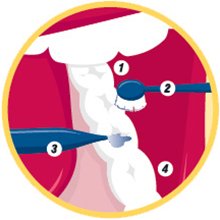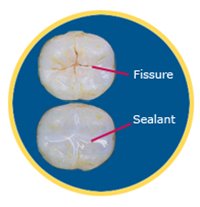Fillings and sealants
Fillings are used to restore teeth to their normal shape, appearance and function by filling in cavities caused by tooth decay. Fissure sealants are of value in the prevention of tooth decay as they fill in the natural pits and fissures in the back (molar) teeth where dental decay occurs most often.
Fillings
Fillings are more often required in the molar (back) teeth where decay rates are higher. The need for fillings due to tooth decay can be eliminated by correctly cleaning your teeth and maintaining a healthy diet. Regular dental health check-ups will make sure any problems are identified and treated early.
The types of filling material used by your dentist may include:
- tooth-coloured fillings
- dental amalgam (silver coloured)
Other forms of tooth restoration, such as gold or ceramic crowns, are an expensive alternative to amalgam and tooth-coloured filling materials.
White fillings
Tooth-coloured (white) fillings have been used in front teeth for cosmetic reasons for many years. Recent improvements in filling materials for back teeth mean these are now more affordable and widely used as an alternative to dental amalgam.
Silver fillings (dental amalgam)
Dental amalgam (‘silver filling’) is an inexpensive and highly durable material commonly used for filling teeth. Modern dental amalgam is a metal alloy that is generally made up of mercury, silver and tin, with small amounts of copper and zinc.
Mercury in dental amalgam fillings
Concerns have been raised about the use of dental amalgam because it contains mercury. While high levels of mercury are harmful to human health, the modern dental amalgam has low mercury content. Repeated international reviews of the scientific evidence have been unable to link the use of dental amalgam directly with ill health.
The current advice from the National Health and Medical Research Council of Australia is that, for most people, these low levels of mercury exposure will not affect their general health.
While there is currently no scientific evidence directly linking amalgam with either ill health or birth defects, pregnant or breastfeeding women and people with kidney disease are not recommended to use amalgam fillings as a precautionary measure. These people should discuss the most appropriate filling material with their oral health professional.
The removal of silver fillings releases mercury into the environment. As such, silver fillings should not be removed unless there’s a good reason to do so (for example, if they are broken, new decay).
Sealants

- The chewing surface of a molar contains natural pits and grooves (fissures) where dental decay occurs most often. The bristles of a toothbrush are too large to reach into some of these areas.
- The tooth is thoroughly cleaned and dried before applying the sealant.
- The liquid sealant is placed onto the surface of the tooth and flows into the pits and fissures. The liquid is then set with an ultra violet light.
- The pits and fissures are now sealed and the tooth surface is smooth and easy to keep clean.

A dental sealant is a tooth-coloured plastic film that is professionally applied to the deep grooves (fissures) on the back teeth (molars) where tooth decay most often starts.
The bacteria in plaque live in these grooves and make acid which causes tooth decay. Dental sealants assist in preventing the build up of plaque acids on the enamel surface of teeth and they are of value in the prevention of tooth decay.
A good time to apply sealants is soon after permanent teeth are fully erupted (after 13 years of age). Discuss with an oral health professional whether this will be beneficial to you.
Fluoride and fluoridated water also play a key role in protecting the teeth against tooth decay.
Read more about the role of fluoride in preventing tooth decay
Related information:
Dental fillings - Better Health Channel
Dental sealants - Better Health Channel
